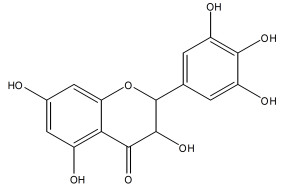Looking For A Dihydromyricetin Supplement?
Where is Dihydromyricetin From?Erythrophleum AfricanumDihydromyricetin Solubility and StabilityStudies on DihydromyricetinHuman use safetyConcerns over alcohol abuseFighting Alcohol Use Disorder (Alcoholism)DHM and The LiverRecommended DosageBuy DHMAsk Us QuestionsDihydromyricetin resources
A new dietary supplement recently hit markets, promising an almost perfect cure from hangovers with zero side effects. Dihydromyricetin (DHM), sometimes called Ampelopsin or Ampeloptin, shows very promising results amongst other so-called hangover cures based on trials performed on rats, mice, and humans.
Research has been ongoing since 2007 and even double blind tests have been met with the same amazing results, near zero side effects from binge drinking and a reduction in a desire to drink. DHM is a flavinol of an ancient tree that continues to show counteractive effects of acute alcohol (EtOH) intoxication.
Where is DHM From
 Dihydromyricetin is an exact from the bark of the cedrus deodara tree. Also called the Himalayan ceder, this tree grows in deciduous regions of southern China, eastern Afghanistan, northern Pakistan, northern India, and southwestern Tibet and Nepal. It grows to a height of nearly 200 feet in mountainous regions of about 500 to 100,500 feet. The gorgeous coniferous evergreen tree is known as ‘tree of the gods’ among the locals and is seen as a spiritual tree.
Dihydromyricetin is an exact from the bark of the cedrus deodara tree. Also called the Himalayan ceder, this tree grows in deciduous regions of southern China, eastern Afghanistan, northern Pakistan, northern India, and southwestern Tibet and Nepal. It grows to a height of nearly 200 feet in mountainous regions of about 500 to 100,500 feet. The gorgeous coniferous evergreen tree is known as ‘tree of the gods’ among the locals and is seen as a spiritual tree.
It has a long history in herbal Ayurveda and is well-recorded for centuries for its therapeutic applications. The inner wood is used for incense, the essential oils make for excellent insect repellant on the feet of camels and hooves of horses, and it contains natural anti-fungal properties, leading to its use as a long-lasting building medium. Its other main uses are for a natural preservative during the shipping of spices, meat, grains, and textiles.
The outer bark is highly astringent, leading to its use for treating respiratory problems, like asthma. It is so potent that those suffering reportedly find benefit by simply sitting under the tree in the early morning as dew mixes with the air and pulls the aromatic oils down for them to breathe. Its characteristic woodsy odour, much like its cousins the ceders in California [1], lead to its usage of floor polishes, disinfectants, soaps, essential oils, and insecticides.
Its most recent rise to fame is for the large amounts of dihydromyricetin (ampelopsin) extracted among other taxifolin, phenols, terpenes, esters, aldehydes, ketones, and alcohols. The flavanol DHM is also less commonly found in the Japanese raisin tree (Hovenia dulcis) and Erythrophleum africanum. Its main effects are that of a hepatprotective and gaba/alcohol receptor inhibitor. (Hepatprotective meaning liver/blood protector. Gaba receptor cells uptake alcohol during consumption and the resulting loss of function from loss of GABA uptake produces the effects of intoxication.)
In China, DHM is commonly known as Teng Cha and is sold/used as a herbal remedy to alleviate fevers, drunkness, cure rheumatism, strengthen physique, diuresis, and many other functions.
Erythrophleum Africanum
Erythrophleum africanum, also known as the African blackwood, is a plant species found in Savannahs of tropical Africa. It produces a gum similar to gum arabic and is a lesser known source of dihydromyricetin [2]. The kilogram amount of dihydromyricetin per plant is comparatively low
Dihydromyricetin Solubility and Stability
DHM, as a substance, is easy soluble in hot water. It is also soluble in ethanol, acetone and/or methanol — hot or cold. Ampelopsin is only slightly soluble in acetic ether, and is completely insoluble in chloroform and petroleum ether.
DHM is stable in heat, but when heated to 100℃ or above, it is irreversibly oxidized. The substance is stable in acidity and neutral.
What Studies Prove Dihydromyricetin is an Effective Hangover Cure?
 Although DHM has been used for centuries for alcohol and other treatments, more recently studies have been conducted on mice, rats, and humans.
Although DHM has been used for centuries for alcohol and other treatments, more recently studies have been conducted on mice, rats, and humans.
Rats and Mice
Researchers tested the gaba response in rats and mice in regards to DHM and gaba blocking. What they looked for was clumsiness, loss of coordination, social skills and cognitive skills. The first test was if they could right themselves after being placed on their backs in a v-shaped cradle and the second was their ability to solve a complex problem via a maze.
Researchers injected each rat with a dose of alcohol (EtOH) equivalent to a human drinking about 20 beers in two hours. The rats who did not receive DHM took an average of 70 minutes to right themselves. Conversely, the rats who received a milligram of DHM per kilo of body weight recovered in less than five minutes! The same injections were given to rats who then were set in a maze. Those without DHM behaved erratically, stumbling around and cowering in corners. Those given DHM showed as much inquisitiveness after five minutes as those without alcohol.

Strangely enough, rats where then tested by injection with a chemical known as flumazenil. This drug is known to block receptors in the brain for the neurotransmitter GABA (gamma aminobutyric acid). Those injected with flumazenil lost all previously gained benefits of the DHM. Researchers concluded that the DHM was an effective sobering supplement due to its ability to stop alcohol from blocking GABA receptors.
“This supports other data that GABA receptors are key in the actions of alcohol and that targeting this interaction is a viable approach to reducing alcohol intake,” says David Nutt of Imperial College London, former head of the British government’s advisory committee on drugs.
“Let’s hope it’s safe to use in humans.”
Human Trials
98% pure dihydromyricetin was administered to humans at the dosage rate of 5mg. Alcohol was administered orally as vodka mixed with orange juice at the rate of 12.7ml per 220-pound 20-year-old male. The men were placed in a room with friends and acquaintances in a lab decorated to mimic living room setting, complete with food and a television.
The first test involved consumption of alcohol at the rate of seven doses followed by a 150mg dose of DHM. Within 30 minutes the test subject felt able to reason and within an hour felt completely sober, but still sleepy.
The second test involved ten doses of alcohol/EtOH followed by a 250mg dose of DHM. Within 30 minutes the test subject felt only vaguely better, within an hour noticed feelings of clarity, within 1.5 hours felt like they were sobering up, at two hours they felt clearer and better (blood alcohol test shows 0.03%), and finally 2.5 hours later, felt close to baseline and sober (blood alcohol test shows 0.01%).
The third test involved four doses of alcohol followed by 450mg of DHM. Within 30 minutes the test subject felt buzzed, but clear. At an hour they reported that DHM had greatly reduced their desire and capped it to four drinks. At only an hour later they felt completely sober and free from intoxication.
The fourth test involved six doses of alcohol followed by 450mg of DHM. After 30 minutes the test subject felt like they were sobering up. After an hour they felt completely sober. And at 1.3 hours later they felt hungry. Though at 1.5 hours they felt nauseated from eating.
The tests are conclusive that DHM does affect a persons ability to become intoxicated, desire alcohol, and sober up after alcohol consumption.
The biggest challenge is ascertaining the correct dose as it varied per person. It is noted that no side effects in mice, rats, or humans have been reported except the residual lessening desire to consume alcohol products. Which was a worry with researchers, who felt that such a product would induce people to drink more since they would not have to deal with the consequences of intoxication.
Is it safe for human consumption?
We covered this exact point after a few people emailed in and asked “has dihydromyricetin been proven as safe for human consumption?”
I’ll quote directly from the article on DHM safety, which you can read here:
“Several groups whose main concern is finding the solution to the rising problem of alcoholism worldwide are hopeful that dihydromyricetin is safe for humans to use.
David Nutt, the former head of the advisory on drugs of the British government, is optimistic that the data gathered on the study involving mice as subjects would have the same results on humans.
…Dr Jing Liang, a pharmacologist who led the research team in the University of California, Los Angeles that spearheaded the first testing of the effects of DHM on humans, claims that DHM does not carry the same side effects, [ed: meaning convulsions and anxiety, the side effects of a different drug called Ro15-4513 that was abandoned] since no signs were evident during the study.”
Researchers Concerned Over Drug Leading To More Drinking Rather Than Less
In 1984 a man named Hoffman-La-Roche developed a similar compound to DHM called Ro15-4513, an alcohol antidote for poisoning cases. Besides the drugs very short half-life (30 minutes on average), development of the compound was abandoned several years ago due in part to concerns over it eventually leading to more drinking rather than less!
“There was a lot of philosophical worry that an ‘alcohol antidote’ would entice people to consume alcohol and then count on being able to terminate the intoxicating effects on demand,” said Markus Heilig, clinical director of the U.S. National Institute on Alcohol Abuse and Alcoholism.
For those struggling to overcome an alcohol addiction — not to mention those affected by the accidents constantly caused by those who’ve had too much to drink, the drug may well be worth the risk!
Using DHM to Fight Alcohol Use Disorder (Alcoholism)
Alcohol use disorders are the most common form of substance abuse, with the World Health Organization revealing that the condition affects more than 76 million people worldwide [3]. Shockingly, harmful use of alcohol results in 2.5 million deaths annually.
In the United States alone, more than 15 million Americans are dependent on alcohol, and 500,000 of those people are between the ages of 9 and 12 years old!
Only an estimated 13 percent of people identified as having an alcohol use disorder receive medical treatment, partly due to a lack of effective medications without major side effects.
In 2008, DHM was approved by the Korea Food & Drug Administration to help liver recovery among people who abuse alcohol. This has increased interest in the extract, both in alternative and mainstream health circles, with the hope that it may be the new and more effective means of treating those with alcoholism that the western world needs.
The human trails mentioned earlier in this article point to more positive signs of DHM becoming a potential treatment for alcoholism.
Dihydromyricetin and The Liver
There have been several in-depth studies on the effect that DHM can have on the liver (mostly as a hepatprotective against alcohol damage to the liver).
One study by Jian Xi & her team called “Effect of juice and fermented vinegar from Hovenia dulcis peduncles on chronically alcohol-induced liver damage in mice” showed that hovenia dulcis extract (DHM as used in Sobur) has a significant protective effect against alcohol-induced liver damage.[4]
A separate study showed that dihydromyricetin also has the ability to reduce injuries all ready caused to the liver. [5]
Essentially, DHM can work to both protect your liver while you drink (if taken beforehand), while also helping to repair damage caused to your liver after one-too-many nights out on the town.
Recommended Dosage
As DHM is still a relatively new herbal drug, it’s dosages have only really been tested on rats and mice. An alcohol extract of 125mg per kg of bodyweight has been used in rats with efficacy, which translates to an estimated human dosage of:
- 1,400mg for a 150lb person
- 1,800mg for a 200lb person
- 2,300mg for a 250lb person
These are estimated human maximum doses based on rat studies. Sobur capsules contain 300mg of dihydromyricetin each, an amount we tested and deemed more then capable of eliminating common hangovers.
Dihydromyricetin Video
To quickly learn about dihydromyricetin and its effects on hangover symptoms, check out our video [6]:
Dihydromyricetin Pills
Sobur, the Hangover Cure Pill contains dihydromyricetin, alongside powerful nutrients and vitamins to fight liver damage and protect the body from harm after a big night out.
Sobur works to eliminate morning hangovers and drastically reduces down-time following drinking. In short: give it a try, it might just change your life!
Ask Us Questions About Dihydromyricetin
Since creating this DHM resource, we’ve received a ton of questions and feedback about Dihydromyricetin and it’s uses, sources (the Hovenia Dulcis tree and other sources for the extract) as well as many individuals from academic backgrounds who want to discuss the herbal extract and it’s implications further.
We update this page frequently and answer many of the questions we receive regularly, but if you have questions of your own about DHM, please use the form below (or email: info@sobur.co) to ask them directly. We respond to every email!
[si-contact-form form=’8′]
Further Dihydromyricetin Resources
We have a bunch of new pages and blog posts detailing all the latest research and intricate details about the dihydromyricetin extract, here are the most popular pages:
- Is Dihydromyricetin Safe For Human Consumption?
- Dihydromyricetin Certificate of Analysis
- The Hepatprotective DHM & Where To Buy
- Dihydromyricetin: Benefits & Drawbacks
- The Japanese Raisin Tree – Hovenia Dulcis
Sources:
- [1] https://en.wikipedia.org/wiki/Ceder_Tree ↵
- [2] http://onlinelibrary.wiley.com/doi/10.1002/ardp.19612940306/abstract ↵
- [3] http://www.who.int/substance_abuse/facts/en/ ↵
- [4] http://www.ncbi.nlm.nih.gov/pubmed/22648047 ↵
- [5] http://www.worldscientific.com/doi/abs/10.1142/S0192415X07005181?journalCode=ajcm&& ↵
- [6] https://www.youtube.com/watch?v=2yQEXL-MqkY ↵


Will DMH help reduce ethyl glucuronide, ETG in the liver?